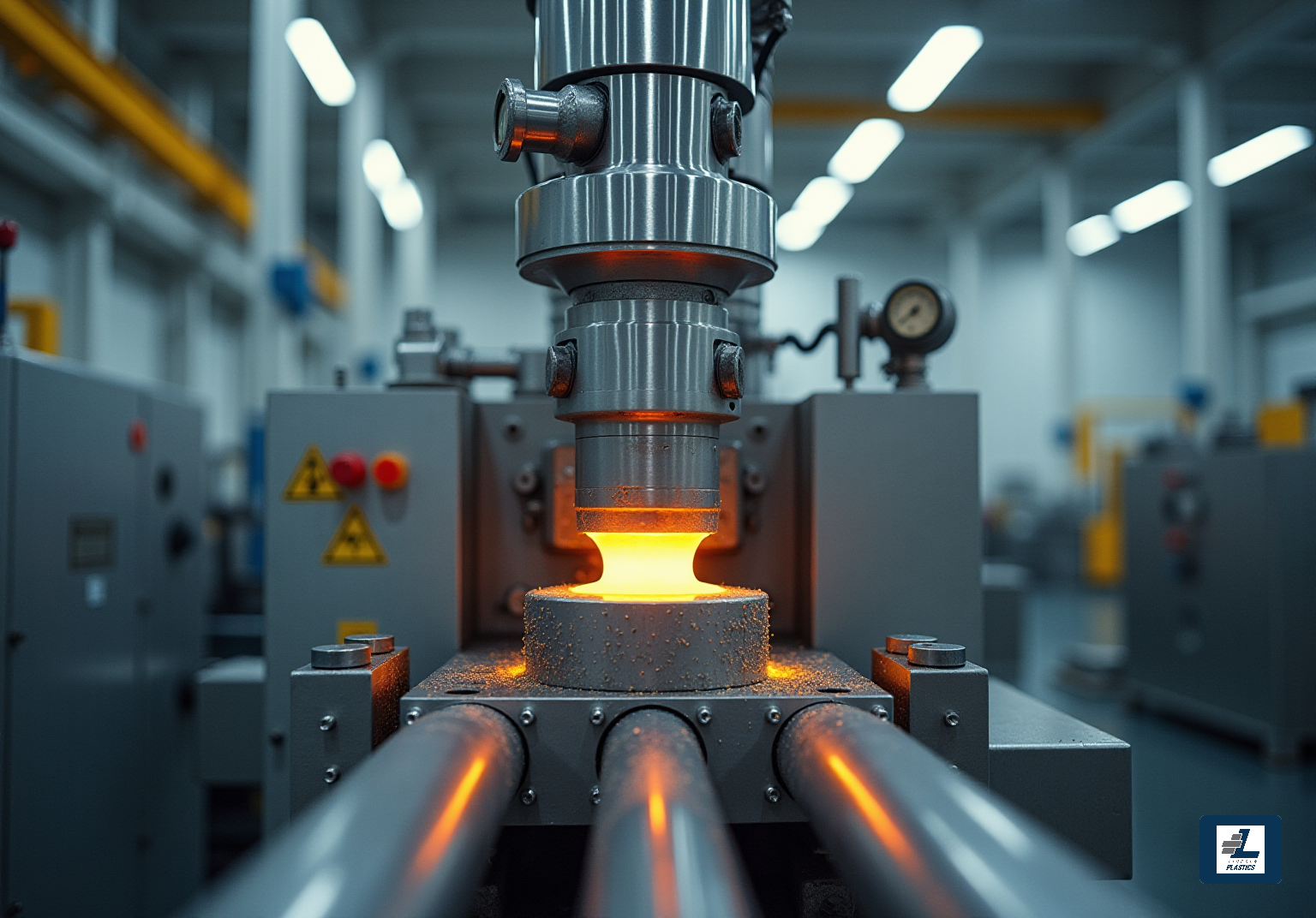
Master Extrusion Head Selection: A Step-by-Step Guide for OEMs
Overview
This article is all about helping OEMs choose the right extrusion heads. It highlights why it's crucial to understand the different types available, the key criteria for selection, and the steps to purchase. By doing this, we can boost production efficiency together!
Now, let’s dive into the different designs of extrusion heads. You’ve got single-screw and twin-screw heads, each playing a unique role in the process. Plus, we can’t forget about important factors like material compatibility and output volume. These elements are key to meeting your operational needs and maintaining quality standards.
So, have you thought about how these choices impact your production? Understanding these aspects can really make a difference in your operations. Let’s explore this together and find the best solutions for your needs!
Introduction
Choosing the right extrusion head can really make a difference in how efficiently and effectively plastic manufacturing processes run. As OEMs dive into the world of extrusion technology, it’s crucial to grasp the ins and outs of different head types and their specific uses.
What hurdles do manufacturers encounter when trying to match their production needs with the right extrusion solutions?
And how can they make sure they’re making smart choices that boost both performance and sustainability?
This guide is here to explore the key elements of extrusion head selection, laying out a step-by-step approach to help OEMs navigate their decision-making journey.
Understand the Basics of Extrusion Heads
The extrusion head and nozzles play a crucial role in the plastic forming process, acting as the vital link between the extruder and the die. Their main job? Shaping molten plastic into specific profiles while ensuring uniform material distribution and precise formation. You might be wondering how shaping nozzles work. Well, they help regulate temperature, oversee pressure, and move materials—all essential for boosting production efficiency.
Industry leaders often highlight that the design of forming nozzles significantly impacts the quality and uniformity of the plastic profiles produced. For instance, advanced designs can enhance thermal stability, which means better management of the shaping process and less waste. Practical examples show that well-designed output nozzles can lead to impressive improvements in production speeds and product standards. This makes them essential for OEMs aiming to meet tough performance criteria.
By understanding these fundamentals, OEMs can make informed decisions when selecting the appropriate extrusion head for their applications, ultimately enhancing operational efficiency and product reliability. Plus, Lincoln Plastics emphasizes quality assurance with a solid quality system that includes a dedicated quality plan for each plastic profile, ensuring they meet regulatory standards. OEMs can rest easy knowing their production solutions are accurate and dependable.
On top of that, Lincoln Plastics provides custom flexible profiles and co-extrusion solutions, which means tailored designs to fit specific operational needs. As the global machinery market for shaping is set to grow, choosing the right forming component becomes even more crucial. With sustainability trends pushing producers to adopt eco-friendly practices, the design and functionality of shaping tools will be key in meeting these evolving demands. So, are you ready to explore your options?
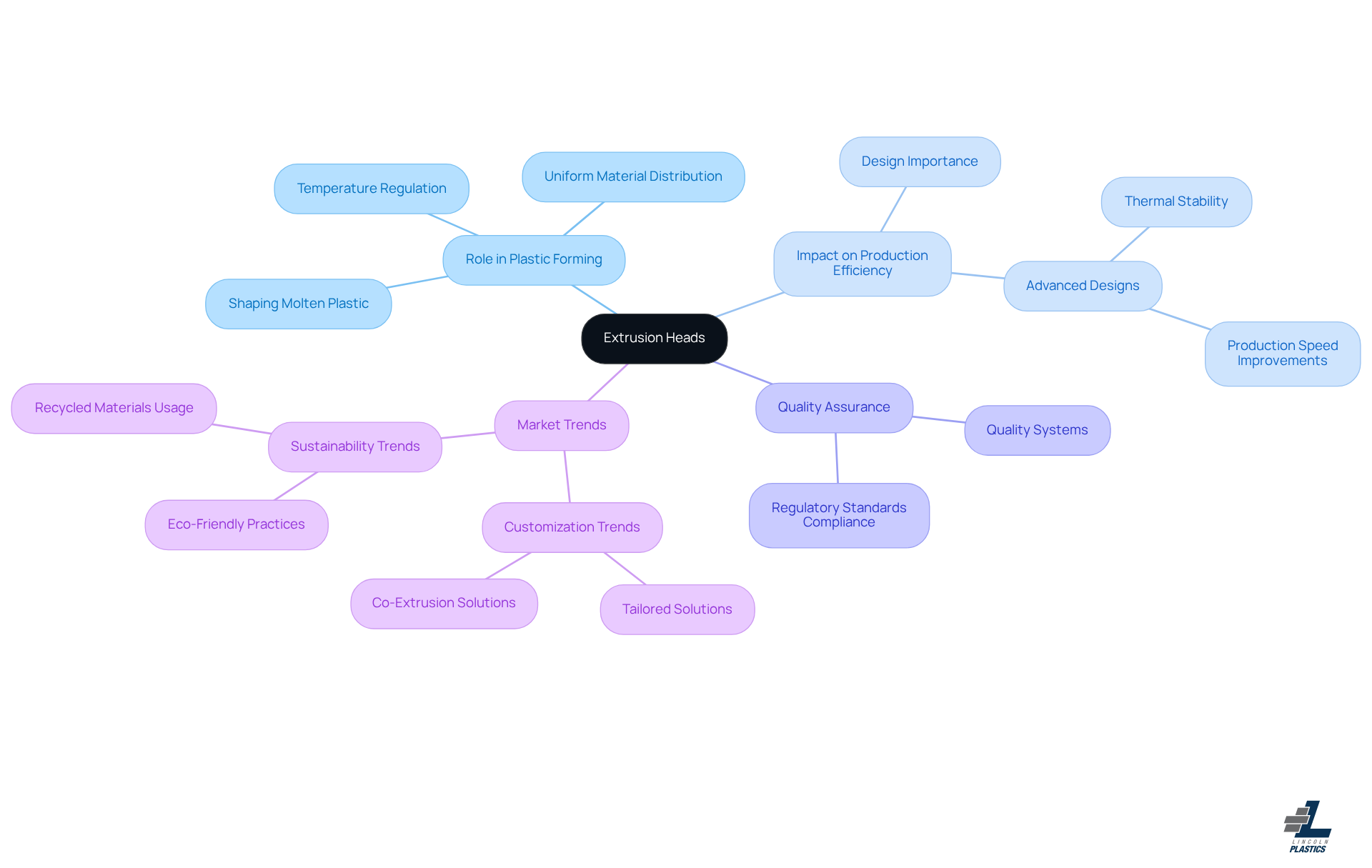
Explore Different Types of Extrusion Heads
Extrusion nozzles play a vital role in shaping the efficiency and quality of the extrusion process. Let’s dive into the various types:
-
Single-Screw Extrusion Heads: These are the go-to choice for creating simple profiles, especially when working with thermoplastics. Their straightforward design makes them perfect for standard applications, providing a cost-effective solution for manufacturers.
-
Twin-Screw Extrusion Heads: If you’re looking for superior mixing and compounding, twin-screw extrusion heads are where it’s at. They handle complex materials and processes like a champ, making them ideal for specialty applications where precision and consistency matter. In fact, case studies show that twin-screw extrusion is gaining popularity in sectors that demand high-quality, customized products. At Lincoln Plastics, we collaborate closely with OEMs to ensure these products meet all quality standards, including special checks for ‘fit and function’ using various gauges to guarantee a proper end-use fit.
-
Co-Extrusion Units equipped with an extrusion head: These advanced components allow for the simultaneous processing of multiple materials, paving the way for multi-layered products. This technology boosts functionality and performance, making it essential for applications that require top-notch barrier properties and material integrity. Plus, we can source colors that align with your Pantone specifications for consistency across manufacturers.
By understanding the unique benefits of each type of output device, OEMs can make informed choices that align with their manufacturing needs and enhance overall operational efficiency. So, what do you think? Ready to explore how these nozzles can elevate your production game?
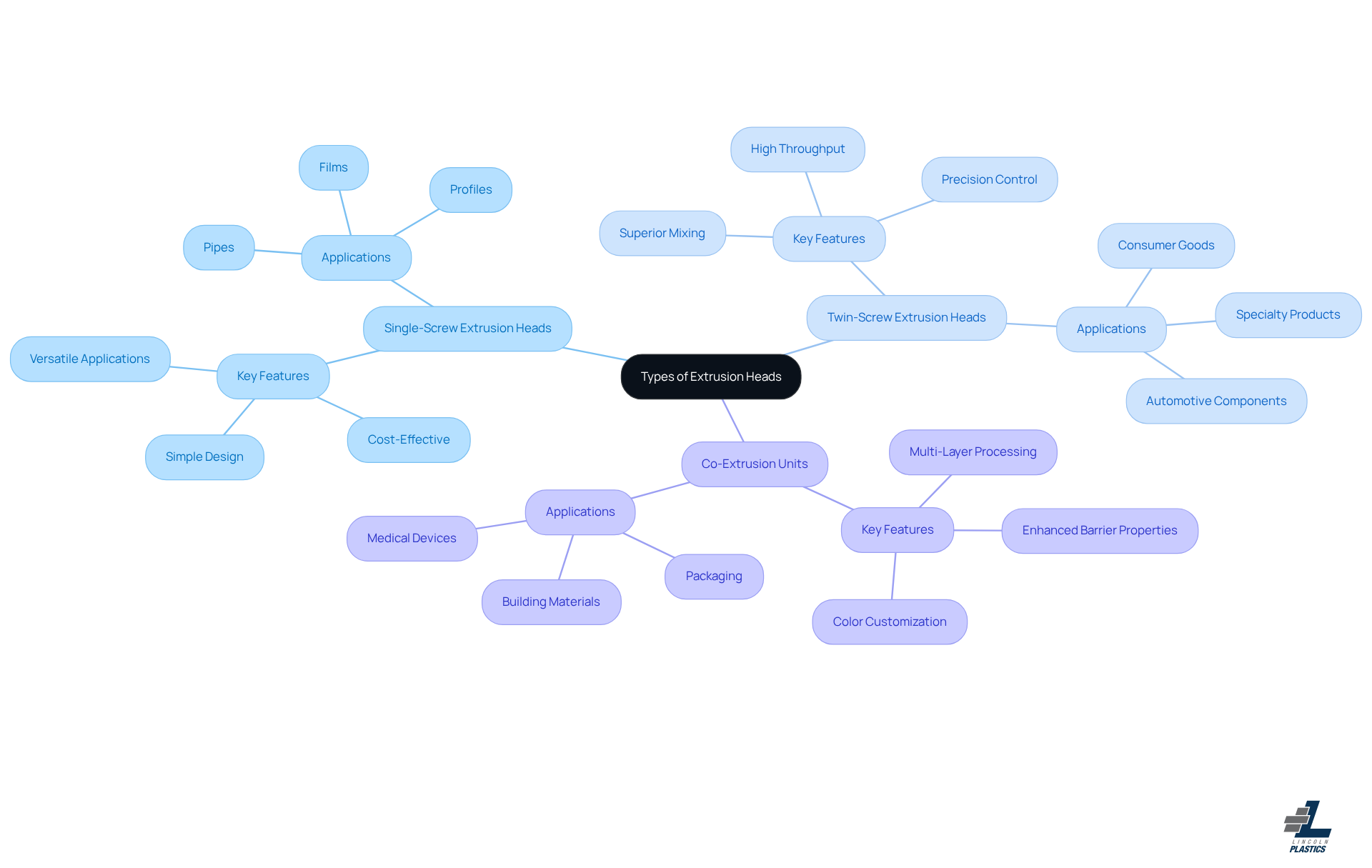
Evaluate Key Selection Criteria for Extrusion Heads
When selecting an extrusion head, it’s important to keep a few key criteria in mind to ensure everything runs smoothly and efficiently.
First up is Material Compatibility. You want to ensure that the specific type of plastic you’re using is compatible with the extrusion head. Different materials have unique flow characteristics and thermal properties, which can really impact the shaping process. By checking compatibility, you help maintain product quality and cut down on potential operational hiccups.
Next, let’s talk about Output Volume. Knowing how much you expect to produce is crucial for figuring out the right size and capacity for your extrusion unit. If you’re ramping up production, you might need larger, sturdier extrusion heads to maintain efficiency and cost-effectiveness. For instance, our usual runs range from 10,000 to 20,000 feet a year, but we can handle over 1,000,000 feet for new pipe or tube projects. Case studies show that if production volumes don’t match, it can lead to extra wear on equipment, which can hurt your bottom line.
Now, consider your Desired Product Specifications. What dimensions, tolerances, and features do you need for the final product? These details shape the design of the output nozzle, ensuring that what you produce meets performance standards and keeps your clients happy. At Lincoln Plastics, we collaborate closely with OEMs to make sure their products meet all quality requirements, including special checks for ‘fit and function’.
Another thing to think about is Ease of Maintenance. A well-designed extrusion component should be easy to clean and maintain. A thoughtful system can significantly reduce downtime and boost operational efficiency, allowing for quicker transitions between manufacturing runs and minimizing interruptions.
Lastly, let’s not forget about Vendor Managed Inventory (VMI). This can be a game-changer for OEMs by optimizing inventory levels. By sharing real-time inventory data, we can help keep stock between minimum and maximum levels, adjusting for seasonal changes. This proactive approach helps prevent delays in manufacturing due to inventory shortages.
So, when you look at all this, it’s clear that considering production volume alongside material compatibility is key to making smart choices about die selection. By focusing on these criteria, you can enhance your operational efficiency and ensure the successful application of shaping technologies.
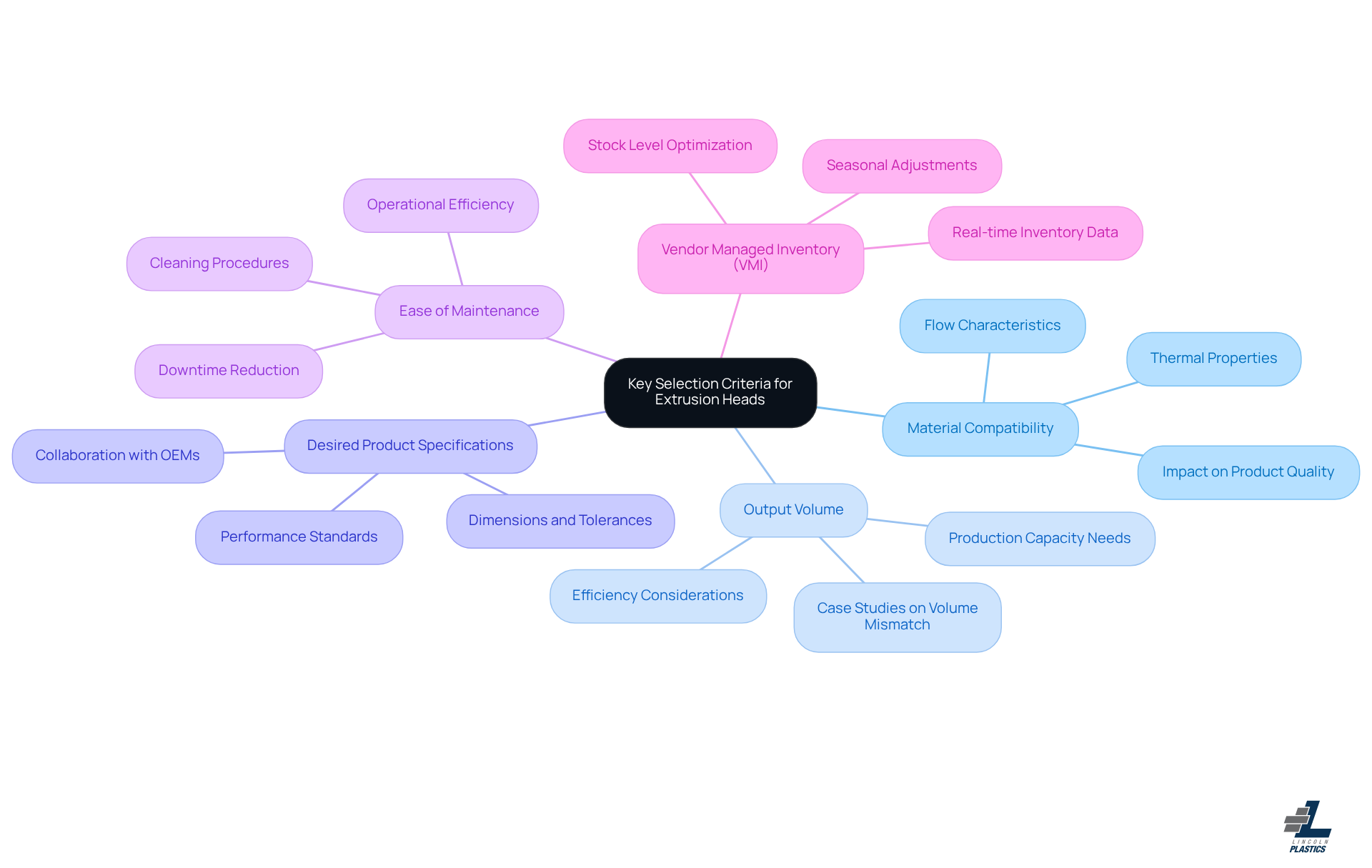
Follow Steps to Purchase the Right Extrusion Head
Looking to purchase the right extrusion head? Here’s a friendly guide to help you through the process:
-
Define Your Requirements: Start by clearly outlining what you need for your production. Think about the material types, desired profiles, and production volumes. This step is crucial to ensure your choice aligns with your operational needs and meets the standards expected by OEMs.
-
Research Providers: Next, seek out trustworthy producers and vendors that specialize in profile nozzles. Use industry directories and online resources to compile a list of potential vendors. Remember, thorough research is key! Industry experts suggest that recognizing suppliers with a proven track record of reliability and excellence is essential—just like Lincoln Plastics, who are dedicated to ensuring their products meet all standards.
-
Request Quotes: Now, reach out to your selected suppliers and ask for quotes based on your defined requirements. Don’t forget to inquire about lead times, warranties, and support services. Did you know that quick responses and comprehensive support are signs of a dependable supplier in the extrusion head sector? This reflects the high standards that Lincoln Plastics upholds.
-
Evaluate Options: Once you have your quotes, it’s time to compare them. Look at price, quality, and supplier reputation. Case studies from OEMs underscore the importance of assessing supplier performance based on past projects to ensure they align with your manufacturing goals. For instance, one study found that companies that thoroughly evaluated their suppliers based on previous results saw a 20% boost in efficiency. This practice mirrors Lincoln Plastics' robust quality system, which includes using check gauges and maintaining a dedicated quality book for documentation.
-
Make a Decision: Choose the supplier that fits your needs best and place your order. Be sure to confirm all details, like delivery timelines and installation support, to avoid any hiccups in your production schedule. It’s also wise to ensure that the supplier can provide documentation and checks similar to those kept by Lincoln Plastics for critical dimensions.
-
Follow Up: After placing your order, keep the lines of communication open with your supplier. This helps ensure timely delivery and allows you to address any questions that may pop up along the way. A proactive approach fosters a collaborative relationship, enhancing your overall purchasing experience. Experts agree that maintaining open communication can significantly reduce the chance of delays and misunderstandings—just like the teamwork Lincoln Plastics engages in with OEMs.
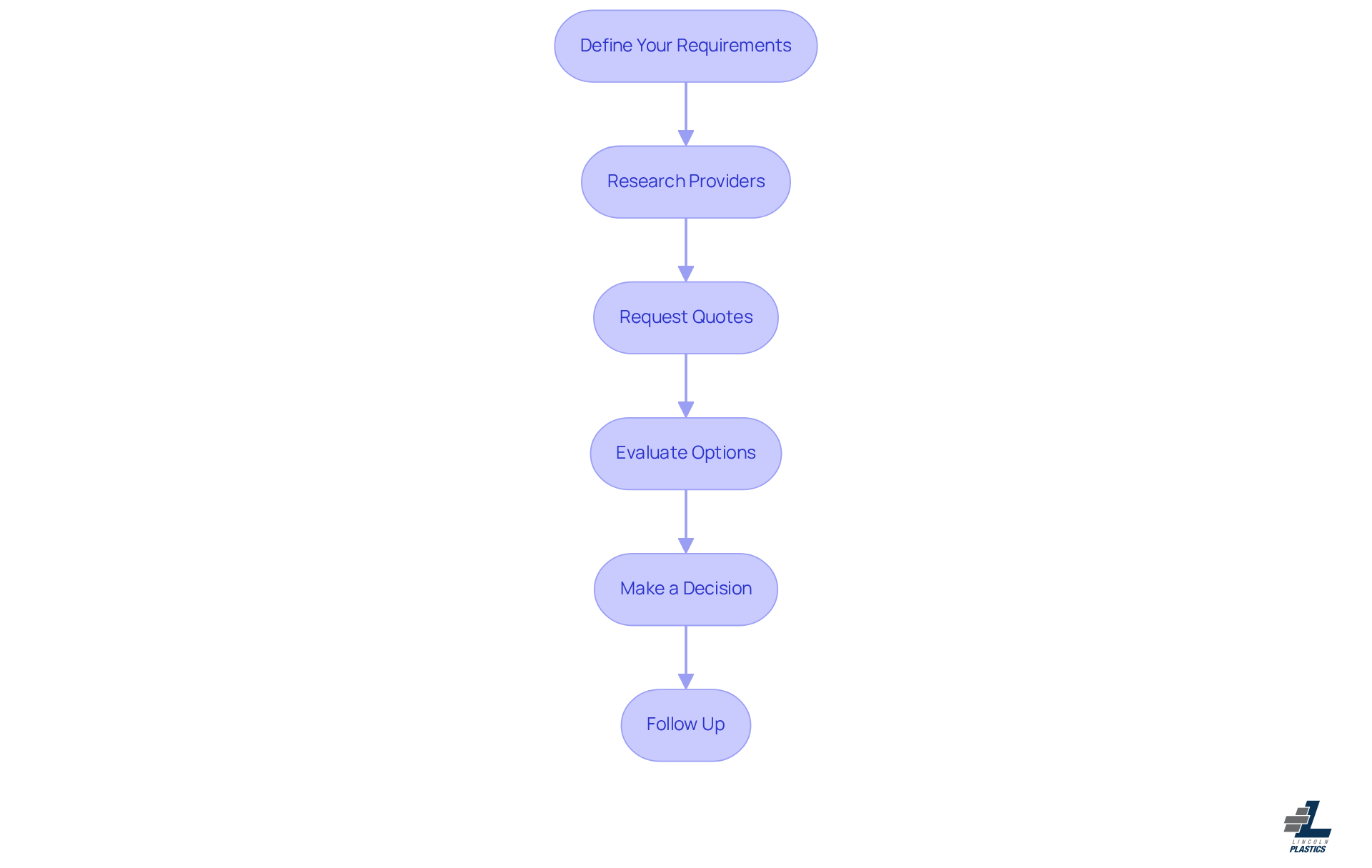
Conclusion
Choosing the right extrusion head is a big deal for OEMs, right? It really impacts how efficiently you produce, the quality of your products, and how reliable your operations are. In this guide, we've covered the key points about extrusion heads, highlighting how they help shape molten plastic and ensure that material is distributed evenly. By getting to know the different types of extrusion heads and what they’re best for, OEMs can make smart choices that fit their manufacturing needs.
So, what should you keep in mind? Well, the following factors are crucial:
- Material compatibility
- Output volume
- Product specifications
- Ease of maintenance
- The perks of vendor-managed inventory
Each of these factors can seriously optimize your extrusion process and boost your overall efficiency. Plus, the step-by-step purchasing guide we provided lays out a clear path for you to follow, helping you pick the right extrusion head for your specific requirements.
In the end, making informed decisions about your extrusion head selection is super important. With the industry changing and demands for sustainability and product customization on the rise, focusing on the right forming components is key to staying competitive. We encourage you to use the insights from this guide to enhance your production capabilities and strive for excellence in your manufacturing processes.
Frequently Asked Questions
What is the role of extrusion heads and nozzles in the plastic forming process?
Extrusion heads and nozzles act as the vital link between the extruder and the die, shaping molten plastic into specific profiles while ensuring uniform material distribution and precise formation.
How do shaping nozzles contribute to production efficiency?
Shaping nozzles help regulate temperature, oversee pressure, and move materials, all of which are essential for boosting production efficiency.
Why is the design of forming nozzles important?
The design of forming nozzles significantly impacts the quality and uniformity of the plastic profiles produced. Advanced designs can enhance thermal stability, improving the shaping process and reducing waste.
What benefits can well-designed output nozzles provide?
Well-designed output nozzles can lead to impressive improvements in production speeds and product standards, making them essential for OEMs aiming to meet strict performance criteria.
How can OEMs make informed decisions regarding extrusion heads?
By understanding the fundamentals of extrusion heads and nozzles, OEMs can select the appropriate extrusion head for their applications, ultimately enhancing operational efficiency and product reliability.
What quality assurance measures does Lincoln Plastics implement?
Lincoln Plastics emphasizes quality assurance with a solid quality system that includes a dedicated quality plan for each plastic profile, ensuring compliance with regulatory standards.
What custom solutions does Lincoln Plastics offer?
Lincoln Plastics provides custom flexible profiles and co-extrusion solutions, offering tailored designs to fit specific operational needs.
Why is choosing the right forming component becoming more crucial?
As the global machinery market for shaping is set to grow and sustainability trends push producers to adopt eco-friendly practices, the design and functionality of shaping tools will be key in meeting evolving demands.
List of Sources
- Understand the Basics of Extrusion Heads
- Future Trends in Extrusion Die Head Technology: What to Expect by 2025 (https://jurryextrusion.com/blog/extrusion-die-head-tech-trends-2025)
- Plastic Extrusion Equipment Market Size, Forecast - 2035 (https://marketresearchfuture.com/reports/plastic-extrusion-equipment-market-40180)
- North America Extrusion Machinery Market Size | Report, 2030 (https://grandviewresearch.com/industry-analysis/north-america-extrusion-machinery-market-report)
- Extrusion Machinery Market – Global Market Size, Share, and Trends Analysis Report – Industry Overview and Forecast to 2032 | Data Bridge Market Research (https://databridgemarketresearch.com/reports/global-extrusion-machinery-market?srsltid=AfmBOopsyYq6CCqjqPDxiWmtV2TVtE6zcpNvzjHkkV82oBjbXhbMS645)
- Extrusion Machinery Market Size | Industry Report, 2030 (https://grandviewresearch.com/industry-analysis/extrusion-machinery-market-report)
- Explore Different Types of Extrusion Heads
- Pipe extrusion: which head to use? | Bausano (https://bausano.com/en/press-and-news/pipe-extrusion-which-head-to-use)
- Extrusion Heads Market Report | Global Forecast From 2025 To 2033 (https://dataintelo.com/report/global-extrusion-heads-market)
- Co Extrusion Line Market Report | Global Forecast From 2025 To 2033 (https://dataintelo.com/report/co-extrusion-line-market)
- Here are 10 key points to understand extrusion dies. (https://prm-taiwan.com/blog/Here-are-10-key-points-to-understand-extrusion-dies_367)
- Co-Extrusion Blown Film Machines Analysis 2025 and Forecasts 2033: Unveiling Growth Opportunities (https://marketreportanalytics.com/reports/co-extrusion-blown-film-machines-333476)
- Evaluate Key Selection Criteria for Extrusion Heads
- Extrusion Heads Market Report | Global Forecast From 2025 To 2033 (https://dataintelo.com/report/global-extrusion-heads-market)
- Extrusion Heads Market Size, Industry Opportunities & Forecast 2033 (https://verifiedmarketreports.com/product/extrusion-heads-market)
- An investigation of additive manufacturing technologies for development of end-use components: A case study | Request PDF (https://researchgate.net/publication/343210059_An_investigation_of_additive_manufacturing_technologies_for_development_of_end-use_components_A_case_study)
- Extrusion Heads Market Report 2025, Market Size, Share, Growth, CAGR, Forecast, Revenue (https://cognitivemarketresearch.com/extrusion-heads-market-report)
- Follow Steps to Purchase the Right Extrusion Head
- 10 Key Insights on Profile Extrusion Plastic for OEM Managers (https://lincoln-plastics.com/news-post/10-key-insights-on-profile-extrusion-plastic-for-oem-managers)
- Answered: Questions About Cost, Order Size, and Lead Time | Profile Precision Extrusions - Aluminum Extrusions Blog (https://profileprecisionextrusions.com/common-questions-answered)
- Pipe extrusion: which head to use? | Bausano (https://bausano.com/en/press-and-news/pipe-extrusion-which-head-to-use)
- Here are 10 key points to understand extrusion dies. (https://prm-taiwan.com/blog/Here-are-10-key-points-to-understand-extrusion-dies_367)
- OEMs forecast high-tech future for extrusion (https://plasticsmachinerymanufacturing.com/extrusion/article/21161172/oems-forecast-high-tech-future-for-extrusion)


